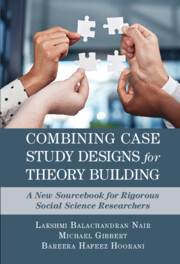 Combining Case Study Designs for Theory Building
Combining Case Study Designs for Theory Building Published online by Cambridge University Press: 02 February 2023
We discuss the single embedded case study design in this chapter. We deliberate how this design is different from multiple and single holistic designs in terms of the levels of analysis and the nature of replication. The selection rationale and sampling are discussed next. Afterwards, we move on to the longitudinal and/or cross-sectional single embedded designs. The strengths and the weaknesses of the design in terms of internal validity, external validity, and the number of variables are discussed subsequently. This chapter also discusses the (mis)conception regarding longitudinal designs and temporal embedded units.
To save this book to your Kindle, first ensure [email protected] is added to your Approved Personal Document E-mail List under your Personal Document Settings on the Manage Your Content and Devices page of your Amazon account. Then enter the ‘name’ part of your Kindle email address below. Find out more about saving to your Kindle.
Note you can select to save to either the @free.kindle.com or @kindle.com variations. ‘@free.kindle.com’ emails are free but can only be saved to your device when it is connected to wi-fi. ‘@kindle.com’ emails can be delivered even when you are not connected to wi-fi, but note that service fees apply.
Find out more about the Kindle Personal Document Service.
To save content items to your account, please confirm that you agree to abide by our usage policies. If this is the first time you use this feature, you will be asked to authorise Cambridge Core to connect with your account. Find out more about saving content to Dropbox.
To save content items to your account, please confirm that you agree to abide by our usage policies. If this is the first time you use this feature, you will be asked to authorise Cambridge Core to connect with your account. Find out more about saving content to Google Drive.